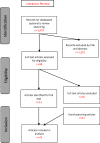Violence against healthcare in conflict: a systematic review of the literature and agenda for future research
- PMID: 33962623
- PMCID: PMC8103060
- DOI: 10.1186/s13031-021-00372-7
Violence against healthcare in conflict: a systematic review of the literature and agenda for future research
Abstract
Background: Attacks on health care in armed conflict, including those on health workers, facilities, patients and transports, represent serious violations of human rights and international humanitarian law. Information about these incidents and their characteristics are available in myriad forms: as published research or commentary, investigative reports, and within online data collection initiatives. We review the research on attacks on health to understand what data they rely on, what subjects they cover and what gaps exist in order to develop a research agenda going forward.
Methods and findings: This study utilizes a systematic review of peer-reviewed to identify and understand relevant data about attacks on health in situations of conflict. We identified 1479 papers published before January 1, 2020 using systematic and hand-searching and chose 45 articles for review that matched our inclusion criteria. We extracted data on geographical and conflict foci, methodology, objectives and major themes. Among the included articles, 26 focused on assessment of evidence of attacks, 15 on analyzing their impacts, three on the legal and human rights principles and one on the methods of documentation. We analyzed article data to answer questions about where and when attacks occur and are investigated, what types of attacks occur, who is perpetrating them, and how and why they are studied. We synthesized cross-cutting themes on the impacts of these attacks, mitigation efforts, and gaps in existing data.
Conclusion: Recognizing limitations in the review, we find there have been comparatively few studies over the past four decades but the literature is growing. To deepen the discussions of the scope of attacks and to enable cross-context comparisons, documentation of attacks on health must be enhanced to make the data more consistent, more thorough, more accessible, include diverse perspectives, and clarify taxonomy. As the research on attacks on health expands, practical questions on how the data is utilized for advocacy, protection and accountability must be prioritized.
Keywords: Armed conflict; Attacks on health; Conflict; Geneva conventions; Hospitals; International humanitarian law; Medicine; Protection; Violence against healthcare; War; War crimes.
Conflict of interest statement
The authors report no conflicts of interest.
Figures
References
-
- ICRC. Geneva Conventions of 1949 and Additional Protocols, and their Commentaries. In: International Committee of the Red Cross [Internet]. 2016 [cited 26 Apr 2016]. Available: https://www.icrc.org/applic/ihl/ihl.nsf/vwTreaties1949.xsp
-
- UN General Assembly. Basic principles for the protection of civilian populations in armed conflicts. A/RES/2675 Dec 9, 1970. Available: https://www.refworld.org/docid/3b00f1c961.html
-
- United Nations general assembly. UN resolution 71/248: international, impartial and independent mechanism to assist in the investigation and prosecution of persons responsible for the Most serious crimes under international law committed in the Syrian Arab Republic since 2011. UN Resolution 71/248 Jan 11, 2017. Available: https://iiim.un.org/mandate/
-
- United Nations Security Council. United Nations security council resolution 2286. 2016. Available: https://www.securitycouncilreport.org/atf/cf/%7B65BFCF9B-6D27-4E9C-8CD3-...
-
- World Health Assembly 65. Resolution WHA 65.20. WHO’s response, and role as the health cluster lead , in meeting the growing demands of health in humanitarian emergencies. 2012. Available: https://apps.who.int/gb/ebwha/pdf_files/WHA65/A65_R20-en.pdf.
Publication types
Grants and funding
LinkOut - more resources
Full Text Sources
Other Literature Sources
Medical
Research Materials
Miscellaneous



